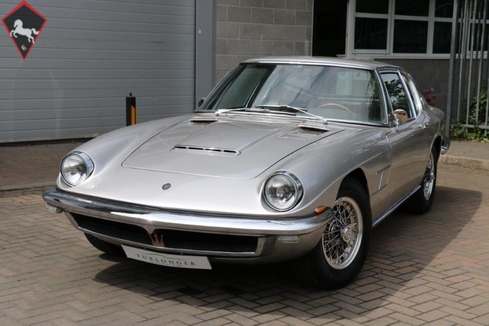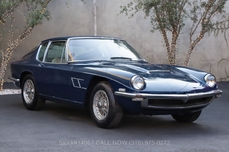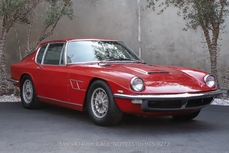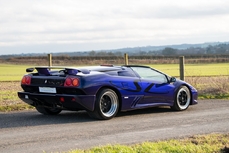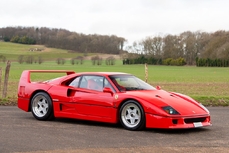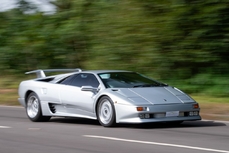Maserati Mistral 4.0 1967
Allgemeine Beschreibung :
The Maserati Mistral is the last model from the Casa del Tridente (“House of the Trident”) to have the company's renowned twin-spark, double overhead cam straight six engine. Fitted to the Maserati 250F Grand Prix cars, it won 8 Grand Prix between 1954 and 1960 and one F1 World Championship in 1957 driven by Juan Manuel Fangio. The engine featured hemispherical combustion chambers fed by a Lucas indirect fuel injection system, a new development for Italian car manufacturers. Maserati subsequently moved on to V8 engines for their later production cars to keep up with the demand for ever more powerful machines.
Three engines were fitted to the Mistral, displacing 3500, 3700 and 4000 cc and developing 235 bhp at 5500 rpm, 245 bhp at 5500 rpm and 255 bhp at 5200 rpm, respectively. Only the earliest of the Mistrals were equipped with the 3500 cc, the most sought after derivative is the 4000 cc model. Unusually, the body was offered in both aluminium and, from 1967, in steel, but no one is quite sure how many of each were built. The automobile was standard with a five speed ZF transmission and four wheel solid disc brakes. Per Maserati practice, the front suspension was independent and the rear solid axle. Acceleration 0-60 for both the 3.7 litre and 4.0 litre engines was around or just under 7 seconds, and top speed approximately 140 mph (225 km/h) to 145 mph (233 km/h). When leaving the factory, the car was originally fitted Pirelli Cinturato 205VR15 tyres (CN72) on Borrani wire wheels. Only the Spyder received the 3500 engine; just 12 were made, along with 76 3.7 L and 37 4.0 L versions. Twenty spyders were right hand drive.
The body was designed by Pietro Frua and first shown in a preview at the Salone Internazionale dell'Automobile di Torino in November 1963. It is generally considered one of the most beautiful Maserati’s of all time. It is also often confused with the very similar looking but larger and more powerful Frua designed AC Frua.
This particular car features the rarer 4.0 Litre engine and was specified in Grigio Platino over Nero interior. 1 of just 822 cars built, it is believed that approximately a quarter of these were 4.0 Litre. This Mistral comes with a well-documented history, many bills and receipts and 2 sets of keys. The car was subject to a full engine rebuild in 2009 carried out by a well-known Maserati Specialist and received a conversion to twin choke carburettors due to the original injection systems being unreliable. This example has proven reliable having completed a 3,000km trip of northern Spain last year.
For further information, please call 01233 646328.
http://simonfurlonger.co.uk/cars/show.php?id=1076&p=100&page=1&srt=price%20DESC
1967 Maserati Mistral 4.0 is listed verkauft on ClassicDigest in Kent by Simon Furlonger for £99990.
Fakten der Auto
Karosserietyp : Auto Marke : Maserati Modell : Mistral Ausführung : 4.0 Hubraum : 4.0 Modelljahr : 1967 Lage : Ashford Kent
Verkauft
Angaben Zum Verkäufer
Verkauft
People who viewed this Maserati Mistral also viewed similar Maserati listed at ClassicDigest
Other cars listed for sale by this dealer
über Maserati
Maserati, das Sinnbild für Italiens feinste traditionelle Luxus-Sportwagen. Lassen Sie uns in die fesselnde Erzählung von Maseratis bewegter Geschichte eintauchen, sollen wir?Akt 1: Die Roaring Twenties
Im Herzen von Bologna, Italien, wurde Maserati 1914 von den Brüdern Maserati gegründet. Die wilden Zwanzigerjahre sahen Maserati dabei, sich als Kraft im Rennsport zu etablieren und Herzen mit seiner präzisen Ingenieurskunst und eleganten Designs zu erobern.
Akt 2: Die Triumphe des Tridents
Das ikonische Trident-Logo tauchte in den 1920er Jahren auf und symbolisierte Maseratis Dominanz in der Rennwelt. Modelle wie der Tipo 26 und der 250F schmückten die Rennstrecken, wobei letzterer Juan Manuel Fangios Formel-1-Weltmeisterschaft 1957 sicherte.
Akt 3: Das Brüllen der Straßenautos (1960er-1980er Jahre)
Maserati wechselte von Rennstrecken auf die Straßen und führte luxuriöse Grand Tourers ein. Der Ghibli, ein Name, der an den Wüstenwind erinnert, und die atemberaubenden Bora und Merak mit ihren Mittelmotor-Designs wurden zu Symbolen automobiler Eleganz.
Produktionszahlen:
Ghibli (1967-1973): Ungefähr 1.170 Einheiten.
Bora (1971-1978): Ungefähr 524 Einheiten.
Merak (1972-1983): Ungefähr 1.830 Einheiten.
Akt 4: Turbulenzen und Triumphe
Die 80er Jahre brachten Herausforderungen, aber Maserati hielt durch. Die Biturbo-Serie sollte die Marke einem breiteren Publikum näherbringen und Leistung mit Luxus verbinden. Trotz Eigentümerwechseln hielt der Geist von Maserati durch.
Produktionszahlen (Biturbo-Serie):
Biturbo (1981-1994): Über 38.000 Einheiten.
Finale: Moderne Eleganz und Kraft
Im 21. Jahrhundert verschmolz Maserati Tradition mit Moderne. Der Quattroporte, GranTurismo und Levante setzten das Erbe fort und vereinten italienisches Handwerk mit modernster Technologie.
Maserati, mit seinem zeitlosen Trident-Emblem, steht als Zeugnis für die italienische Leidenschaft sowohl im Rennsport als auch in der luxuriösen Handwerkskunst. Durch Triumphe und Tragödien hat sich Maserati in die Annalen der Automobilgeschichte als Symbol für Stil, Leistung und Streben nach Perfektion eingeprägt. Sehen Sie auch die BiTurbo-Restaurierungsgeschichte: Link zum Artikel
